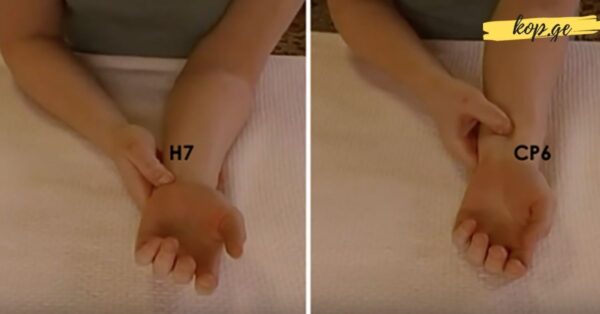Press These Points on Your Wrist to Fall Asleep Faster and Relieve Anxiety!

Anxiety and insomnia are two of the most common health challenges in today’s fast-paced world. Stress, overworking, constant exposure to screens, and lifestyle pressures contribute to these conditions, making it difficult for many people to unwind and get a restful night’s sleep. While medications and professional therapies are often recommended, there are also natural, drug-free methods that can be highly effective—one of which involves acupressure points on your wrist. By stimulating specific points on your body, you can calm your nervous system, relieve tension, and improve sleep quality.
Understanding Acupressure
Acupressure is a therapeutic technique derived from Traditional Chinese Medicine (TCM), similar in principle to acupuncture but without the use of needles. Both methods aim to stimulate specific points on the body to influence energy flow, or “Qi,” and activate the body’s self-healing mechanisms. In acupressure, however, pressure is applied using fingers, palms, or specialized tools instead of needles. This makes it a safe and accessible technique that anyone can practice at home, in the office, or even while traveling.
The theory behind acupressure is that the body contains hundreds of points connected by energy channels known as meridians. Stimulating these points helps regulate the nervous system, reduce tension, improve circulation, and balance physical and emotional states. For those struggling with insomnia and anxiety, acupressure focuses on calming overactive nervous activity, slowing down heart rate, and encouraging relaxation—preparing the mind and body for restorative sleep.
Wrist Acupressure Points for Anxiety Relief
Two specific acupressure points on the wrist have been shown to effectively reduce anxiety and promote calmness: Pericardium 6 (PC6) and Heart 7 (HT7).
1. Pericardium 6 (PC6)
PC6 is located on the inner side of the wrist, about three finger-widths below the base of the palm, between the two tendons. This point is commonly used to relieve anxiety, nausea, palpitations, and motion sickness. Stimulating PC6 helps regulate the autonomic nervous system, which controls the fight-or-flight response, and encourages a sense of calm throughout the body.
2. Heart 7 (HT7)
HT7, also known as the “Spirit Gate,” is found on the wrist crease, at the base of the palm, just below the little finger. This point is traditionally used to calm the mind, relieve stress, and improve sleep quality. Regular stimulation of HT7 can help reduce emotional tension and improve overall relaxation, making it easier to fall asleep and stay asleep through the night.
How to Apply Acupressure
Step-by-Step Instructions:
Locate the Points: Begin by identifying the PC6 and HT7 points on both wrists. For PC6, measure about three finger-widths down from your wrist crease. HT7 is located directly on the wrist crease, beneath the little finger.
Apply Gentle Pressure: Use your thumb or index finger to press firmly on the point. The pressure should be strong enough to feel the tension release but should never cause pain.
Use Circular Motion: While applying pressure, move your finger in small circular motions. This enhances stimulation and helps activate the energy flow through the meridians.
Timing: Maintain pressure for approximately 2 minutes on each point. For HT7, a slightly longer period of 2–3 minutes may be beneficial if you are especially tense or anxious.
Breathing: Breathe slowly and deeply while performing acupressure. Inhale through your nose and exhale through your mouth, allowing your body to relax with each breath.
How Acupressure Helps Insomnia
Insomnia often arises from heightened stress levels, an overactive mind, or irregular sleep patterns. By targeting the PC6 and HT7 points, acupressure works to:
Reduce racing thoughts before bedtime
Lower heart rate and blood pressure
Encourage a state of relaxation in both mind and body
Improve the quality and duration of sleep
For best results, perform acupressure 30–60 minutes before bedtime. This gives your body enough time to enter a relaxed state before sleep. The technique can also be used during the night if you wake up and struggle to fall back asleep. Over time, regular practice can retrain your nervous system to respond more calmly to stressors, helping you maintain better sleep habits naturally.
Additional Benefits
Beyond aiding sleep and reducing anxiety, acupressure has other holistic health benefits:
Mood regulation: Stimulating PC6 and HT7 can reduce feelings of irritability, restlessness, and mild depression.
Stress management: Daily acupressure sessions help mitigate cortisol spikes and promote overall emotional balance.
Digestive support: PC6 is also effective in relieving nausea, bloating, and mild stomach discomfort, which can indirectly improve sleep quality.
Circulation improvement: Regular stimulation of wrist points enhances blood flow to the hands, arms, and chest, promoting overall physical vitality.
Tips for Effective Practice
Consistency is key: Performing acupressure daily, ideally at the same time each evening, maximizes benefits.
Combine with other relaxation techniques: Pair acupressure with gentle stretching, meditation, or calming music for a more profound effect.
Stay hydrated: Drinking water after acupressure helps flush out stress-induced toxins and supports overall wellness.
Avoid excessive pressure: Pain or bruising indicates too much pressure. Gentle, steady pressure is sufficient.
Conclusion
Acupressure is a simple, non-invasive, and natural way to combat anxiety and insomnia. By focusing on wrist points like PC6 and HT7, you can activate your body’s relaxation response, calm your nervous system, and enjoy deeper, more restful sleep without the need for medications. Whether used as part of a nightly routine or in moments of daytime stress, acupressure offers a practical tool for improving mental and physical well-being.
By integrating these techniques into your daily life, you not only support better sleep and reduced anxiety but also empower yourself with a natural, holistic approach to health. Over time, these small, mindful practices can contribute to a more balanced, peaceful lifestyle, helping you feel rested, alert, and emotionally resilient.












